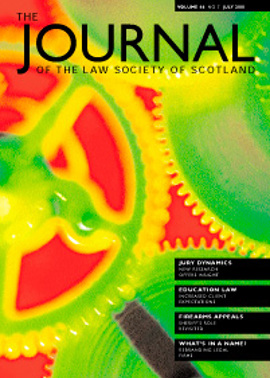Book reviews
The genesis of these volumes lies largely in being a counterpart book to Southern Cross, a large-scale attempt to trace the history of legal doctrine in South African law, showing how the Dutch variant of the European jus commune was transplanted to the Cape of Good Hope in the 17th century, influenced by English law in the 19th and 20th centuries and acquired an identify which was neither purely Roman-Dutch nor purely English. The other factor was that “today... we see the age of more or less autonomous systems of national law gradually drawing to its close... Private law in Europe is in the process of reacquiring a transnational character ... The narrowness, but also the security of a national system of private law is increasingly left behind and we are moving towards a new jus commune”. This is questionable. Accordingly a team of contributors was assembled from a number of different countries, mostly from the Scottish law schools, and at a preliminary meeting held in the University of Regensburg in January 1997, a common approach was discussed and agreed upon. Each contributor was then asked to prepare a paper on a selected area. The obvious model was Southern Cross.
The first comment which has to be made is that the title of the volumes is misleading. They are not a history of private law but a series of essays on the history of selected topics of doctrine from the fields of property and obligations, and there is nothing about the other fields of private law, such as family law, children, succession, international private law, associations and companies and many of the individual kinds of contracts such as carriage or employment. This Vol I contains a generally chronological historical introduction outlining the story of private law from the mergence of the Scottish kingdom to 1832, but not very much of interest and historical importance happened thereafter. It contains also, under the general heading of Property Law, ten substantial essays on doctrinal topics such as servitudes, rights in security over moveables, assignation and water law regimes. But they all look at their subjects from the Roman law and jus commune standpoint, very much as Bankton and Erskine saw a Roman law source or at least analogy for practically everything, and understate the influence in the land law of feudal law and the apparatus of charters, sasines, tenures, wadsets, notarial instruments and much more which constituted the major and basic elements of land law. Of course Roman law contributed to property law but sometimes, as in prescription, little more than the general idea of time cutting off claims. Moreover Roman law contributed more to moveable property law than to land law.
This is accordingly a rather partial and biased approach to legal history in looking always for, and at, topics which have drawn from Roman law and ignoring the rest. The history of bills of exchange and copyrights, for example, are very interesting but are here excluded.
The second volume contains 21 essays on topics within the field of obligations, 13 on topics of contracts, one on unjustified enrichment and seven on topics of delict. As obligations is well known as the area of private law most affected by borrowing of ideas and rules from Roman law and the jus commune this is natural and right. Thus there are essays on force and fear, breach of contract and contractual restrictive covenants, on negligence, strict liability and vicarious liability. The only specific contracts discussed are sale and insurance. It is natural and right that sale should be discussed because the Roman law basis was obvious and comprehension of the regrettable changes made in 1893 requires understanding of that basis. But it is rather surprising that there is no essay on cautionary obligations, which would, it is thought, have yielded some interesting historical and comparative comments.
It is, however, one of the inescapable difficulties of the essay approach, dealing with particular themes, that, while each follows the theme from its early appearances to much later times, at no point does one get an impression of how the law of property or contract or delict stood at particular points of time, of how much of it was constituted or influenced by Roman or other external influences. How strong was the Roman influence by, say, the mid-19th century?
Nevertheless there is an immense amount of interest, importance and value in these essays. They have been most thoroughly researched and make substantial additions to our understanding of the themes. In most cases they are the first substantial attempts to go beyond the vague and general statements that Scots law has drawn much from Roman law or has been extensively influenced by Roman law, in that they examine closely and carefully, with a wealth of citation, the Roman influence on particular topics of Scots law and on many points amplify or question or correct what were hitherto established views. But the same needs to be done for other major influences to secure a balanced picture. A hypothetical non-Scots lawyer with an interest in Scottish private law, such as a Canadian of Scottish ancestry, would be liable to get an incomplete, disjointed understanding of even the two areas examined and practically none of the other major areas of private law, such as family law and succession. Nevertheless the volumes represent substantial contributions consideration when seeking to make further advances.
David M. Walker






